Coffee, where does it come from and which is the right one for me?
Posted by Andrea Vetter on
A Brief History
Coffee, unlike tea, which has been around since before the pyramids in Egypt were built, is a relatively new kid on the block, but the origins of its discovery is just as shrouded in mystery and myth. The coffee plant grew wild on the plateaus of Ethiopia, and is still one of the rare places it spontaneously grows. According to one legend, instead of being discovered by royalty or an emperor, a goat herder named Kaldi noticed his goats were livelier than usual, and like spun up toddlers, stayed awake during the night. He saw that they had eaten red berries and tried them, and realized they made him feel more alert. He shared his discovery with an abbot at a local monastery, and the monks started using the berries to stay alert during long prayer sessions.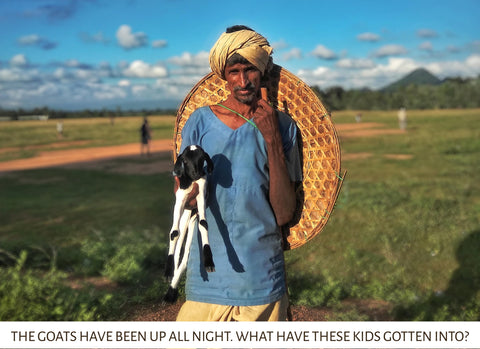
Coffees’ popularity was slow to grow though, it wasn’t until the fifteenth century that it gained popularity on the Arabian peninsula and spread through the Near East, especially after its use reached Mecca and pilgrims brought it back to their homes. Coffee shops opened up and became centers of social activity and entertainment.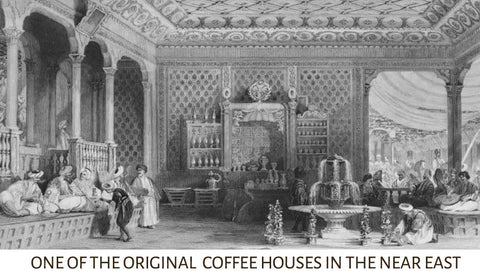
It was another two centuries before coffee finally reached Europe, but it wasn’t originally accepted. The clergy in Venice called it “The bitter invention of Satan.” Of course this was during a time of ignorance and superstition, and anything new was evil. Tomatoes had been recently introduced from the new world and were considered poisonous, and called the “wolf peach”, because it was, you guessed it, evil. Thankfully Pope Clement VIII intervened, and taking a huge chance, tasted the coffee and found it to his liking, and even went so far as baptizing the coffee, and giving it Papal approval.

We have a coffee cup celebrating this joyous occasion. You can find it here.

https://www.electricbluebeebop.com/collections/coffee-cups/products/satans-drink-coffee-mug
Soon, coffee houses opened up all over Europe, and became popular social centers. During this time period, day drinking was definitely a thing, and it was common for people to start their day with a hearty cup of beer. As coffee began to replace beer, it was found that the coffee drinkers were often more productive, which really isn’t a big surprise. It still took a while though for coffee to become the morning drink.

At first coffee was grown exclusively in the Arab world, and they guarded the cultivation closely. It wasn’t until 1690 that the Dutch successfully smuggled seedlings out of the Port of Mocha in Yemen, that coffee was grown elsewhere. They tried planting first in India, but were unsuccessful. The next attempt in Indonesia was successful, the plants liked the tropical environment and some of the best coffees still come from there. It was only a matter of time before coffee was grown in locations around the world, and today is world’s second largest traded commodity, only after crude oil.
So, now I now the history of coffee and that it is grown worldwide, but which one is best for me?
There are basically two types of beans that are available commercially, Arabica and Robusta. Both are grown in over 80 countries located in the coffee belt, and area along the equator and between the Tropics of Capricorn and Cancer, areas that have a similar climate to coffee’s origin in Ethiopia.
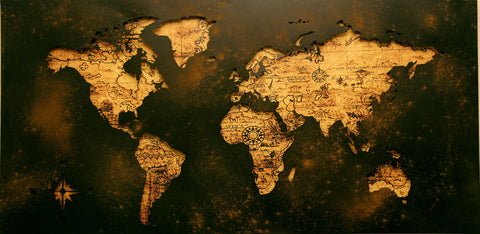
Arabica is often thought of as the eldest since it was first discovered, but Robusta is actually the parent. Arabica is the more refined bean, sweeter in taste, but delicate as well. Arabica is more popular, but more difficult to grow, preferring higher altitudes, but even in ideal climates, produces less than Robusta, and is prone to disease.

Robusta is the brash bean, less acidic than Arabica, but higher in caffeine content. Robusta produces more beans, can be grown at lower altitudes, is less prone to disease, and can be planted for machine harvesting, making it less expensive than the finicky and handpicked Arabica. The taste is often considered lower in quality, it is less sweet and has a lower sugar content. Quality control standards for Robusta coffee are also lower than for Arabica, but industry standards are changing and improving.
Robusta beans are often added to coffee blends to save expenses but also to balance out the taste, similar to how wines are blended. Robusta is often added to coffees for people that want a higher caffeine content and an extra boost from their cup of joe.
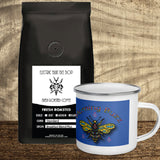 We offer a high caffeine blend of coffee that is worth trying if you need an extra jolt!
We offer a high caffeine blend of coffee that is worth trying if you need an extra jolt!
https://www.electricbluebeebop.com/collections/blended-coffee/products/breakfast-blend-1
Ok. So there are two types of beans used commercially, but what are the differences between single origin and blended coffees, and what exactly is a flavored coffee?
Coffee tastes vary from the regions they are grown in, but here is a quick guide.

African Coffees are often tangy and fill the palate with a fruity essence and delightfully nutty aftertaste. Coffee originated in Africa and this region is associated with how coffee initially tasted. Perhaps it was serendipity, but the first coffee I ever tasted that didn’t come in a can from the grocery store was an Ethiopian coffee. Independent coffee shops were trending, and the aroma of the coffee beans filled the air outside of the coffee shop. It was one of the best cups of coffee I ever tasted, and at the time, a unique experience.
Several of our African coffees include:
- Ethiopian Single Blend https://www.electricbluebeebop.com/collections/single-origin-coffee/products/ethiopia-natural
- African Espresso https://www.electricbluebeebop.com/products/african-espresso?_pos=1&_sid=ddc6f9eba&_ss=r
- African Kahawa https://www.electricbluebeebop.com/products/african-kahawa-blend?_pos=2&_sid=ddc6f9eba&_ss=r

Indonesian Coffees are bold and full bodied, often feel creamy and pleasant on the palate, due to a higher oil content. Indonesia is the region coffee was first successfully grown out of Africa, and depending on the region, the aftertaste can be long and lingering, with a fulfilling earthy taste. Our favorite is Bali Blue. The taste is sublime and exquisite.
- Bali Blue Indonesian https://www.electricbluebeebop.com/collections/single-origin-coffee/products/bali-blue

Central and South American Coffees are mild and smooth, but not necessarily bland and unremarkable. Brazilian coffee beans are the most common in the world, and associated with the coffee taste most of us are familiar with. Peruvian coffee is grown at high altitudes that contribute to a deep and rich flavor, and the volcanic loam of Costa Rica creates a balanced acidity in the beans.
- Brazil Santos https://www.electricbluebeebop.com/collections/single-origin-coffee/products/brazil-santos
- Peru https://www.electricbluebeebop.com/collections/single-origin-coffee/products/peru
- Costa Rica https://www.electricbluebeebop.com/collections/single-origin-coffee/products/costa-rica
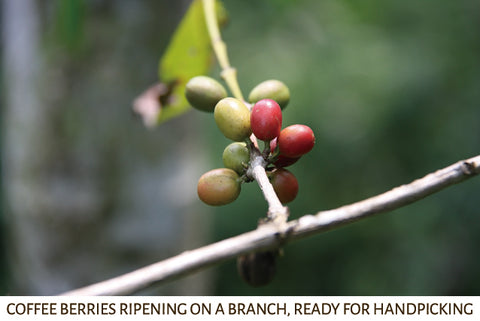
Single Origin Coffees are where you will get the most nuances in flavor and aroma. Like a fine wine, the taste of a single origin coffee depends on the location it is grown, the weather the year it is harvested, and most importantly, the soil it is grown in. Single origin coffees can come from a single lot, single estate or a region. It is enjoyable tasting coffees from different regions and discovering the variety of flavors from around the world, how coffee grown in volcanic soil differs from coffee grown in deep, sandy loam, or how coffee grown at a higher altitude might have a mellower yet richly developed taste.
Some of our bestselling single origin coffees:
- Tanzania https://www.electricbluebeebop.com/collections/single-origin-coffee/products/tanzania
- Guatemala https://www.electricbluebeebop.com/collections/single-origin-coffee/products/guatemala
- Mexico https://www.electricbluebeebop.com/collections/single-origin-coffee/products/mexico

Blended Coffees are two or more types of beans blended together before or after roasting. Coffees are blended to create continuity in taste, or to create a balance between acidity, mouth feel, and aroma. Blending coffee is an art form and takes skill and experience, but the end result is often delightful and worth trying.
Some blends worth waking up too.
- Cowboy Blend https://www.electricbluebeebop.com/collections/blended-coffee/products/cowboy-blend
- Breakfast Blend https://www.electricbluebeebop.com/collections/blended-coffee/products/breakfast-blend
- Asian Plateau Blend https://www.electricbluebeebop.com/collections/blended-coffee/products/asian-plateau-blend

Flavored Coffees are a great way to add certain tastes and flavors to a coffee without adding calories. Flavored oils are added to the beans after roasting, and while still warm, the beans are infused with an extra pizazz of taste and aroma. It is a great way to add taste to coffee without adding extra sweeteners. We offer pumpkin spice flavored coffee year round, but that's probably because we enjoy pumpkin pie year round too! Cinnabun is a wonderful way to enjoy the taste of a frosted cinnamon roll, and the Mexican Chocolate is a real treat.
- Cinnabun https://www.electricbluebeebop.com/collections/flavored-coffee/products/cinnabun
- Mexican Chocolate https://www.electricbluebeebop.com/collections/flavored-coffee/products/mexican-chocolate
- Pumpkin Spice https://www.electricbluebeebop.com/collections/flavored-coffee/products/pumpkin-spice
That’s fabulous, but what are the differences between a light, medium, and dark roast?

There’s long been a misconception that a dark roasted coffee equals a stronger tasting coffee, and that it has a higher caffeine and acidity content. In fact the opposite is often true.
Light Roasted Coffee are beans roasted for the least amount of time, only to first crack, or an internal temperature of 356F-401F. The beans haven’t been roasted long enough to release the oils and caffeine, resulting in a higher caffeine and acidic coffee. Don’t let the name fool you though, light roasted coffee beans retain the taste of their origin more than a darker roast and often have a citrusy, fruity taste.
Our breakfast blend is a great way to experience the taste of a lightly roasted coffee.
- Breakfast Blend https://www.electricbluebeebop.com/products/breakfast-blend?_pos=6&_sid=d94001a51&_ss=r
Medium Roasted Coffee are beans roasted to a temperature of 410F-428F, between the first and second crack. Medium roast is the most common roast, and creates a fine balance between keeping the original flavors of the bean, and bringing forth a bolder flavor. Medium roasts are usually less acidic than a light roasted coffee.
Three of our favorite medium roasted coffees are:
- Asian Plateau https://www.electricbluebeebop.com/products/asian-plateau-blend?_pos=17&_sid=e8fb2516b&_ss=r
- Gourmet Donut Shop https://www.electricbluebeebop.com/products/gourmet-donut-shop?_pos=24&_sid=2bbb60d65&_ss=r
- Papua New Guinea https://www.electricbluebeebop.com/products/papua-new-guinea?_pos=28&_sid=2bbb60d65&_ss=r
Medium Dark Roasted Coffee are beans roasted to the second crack, to a temperature between 437F-446F. This is where interesting things begin to happen as the heat creates chemical reactions. The oils start releasing and flavors intensify.
Three great ways to try a medium dark roast :
- Guatemala https://www.electricbluebeebop.com/products/guatemala?_pos=4&_sid=555d5eb6e&_ss=r
-
Latin American Blend https://www.electricbluebeebop.com/products/latin-american-blend?_pos=7&_sid=5c06be4f9&_ss=r
-
Cowboy Blend https://www.electricbluebeebop.com/products/cowboy-blend?_pos=3&_sid=5c06be4f9&_ss=r
Dark Roasted Coffee are beans roasted to the second crack or beyond, to a temperature of 464F-482F. There is a fine line between caramelized sweetness and charred bitterness. While dark roasted coffee has the lowest caffeine and acidity levels, it also has none of the flavors of the bean’s origins, they’ve been roasted out. The heat has also created chemical changes releasing the oils and making the beans shiny. Some popular dark roasts are Italian and French roasts.

Try our darkest coffee roasts.
- Italian Roast: https://www.electricbluebeebop.com/products/italian-roast?_pos=1&_sid=8fe4edf97&_ss=r
- French Roast: https://www.electricbluebeebop.com/collections/blended-coffee/products/italian-roast
Finding the right coffee for you is a matter of personal preference and taste. It can also depend on your mood, time of day or year, and location. A heady dark roasted coffee often tastes better after a gourmet dinner than first thing in the morning, while a lightly roasted coffee tells a nuanced story of where it comes from, the soil it grew in, its journey to the coffee roaster, and finally to you. There are no set rules, but we hope our guide has given you an idea of where to begin on your coffee tasting journey.
